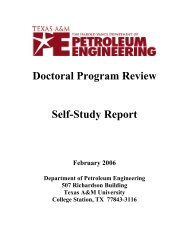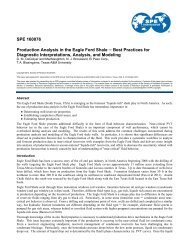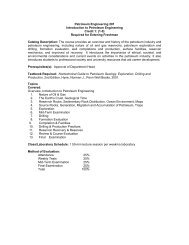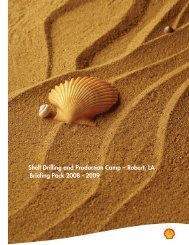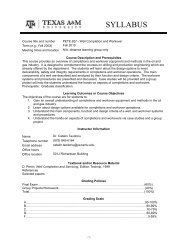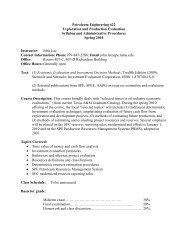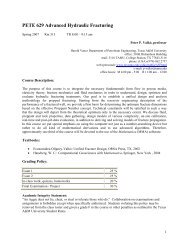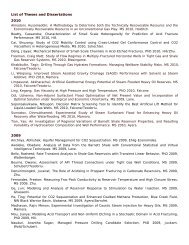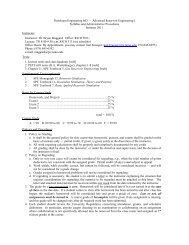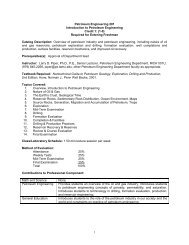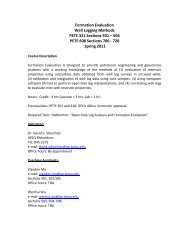Crisman Annual Report 2009 - Harold Vance Department of ...
Crisman Annual Report 2009 - Harold Vance Department of ...
Crisman Annual Report 2009 - Harold Vance Department of ...
You also want an ePaper? Increase the reach of your titles
YUMPU automatically turns print PDFs into web optimized ePapers that Google loves.
Propagation <strong>of</strong> Induced Hydraulic Fractures near Pre-Existing Fractures<br />
Objectives<br />
Hydraulic fracturing is a widely used technology<br />
for stimulating oil and gas wells. The intersection<br />
<strong>of</strong> hydraulic fractures with natural fractures or<br />
other discontinuities in a rock mass can give rise to<br />
significant changes to fracture growth. The objective<br />
<strong>of</strong> this project is to study the potential propagation<br />
behaviors <strong>of</strong> hydraulic fractures near pre-existing<br />
fractures considering linear and non-linear fault<br />
behavior and poroelastic effects.<br />
Approach<br />
We use 2D boundary element method to model<br />
the stress field ahead <strong>of</strong> a hydraulic fracture in the<br />
vicinity <strong>of</strong> a pre-existing fracture. A unified structural<br />
criterion is used to predict the crack propagation<br />
behavior. The work initially considers fractures in an<br />
elastic media. Poroelastic effects, which arise from<br />
coupling <strong>of</strong> rock deformation and fluid flow inside the<br />
fracture, are considered next. Propagation behaviors<br />
<strong>of</strong> single pressurized crack and interaction between<br />
multiple cracks are studied. And finally, interaction<br />
between hydraulic fractures and natural fractures in a<br />
homogeneous poroelastic media will be investigated.<br />
Accomplishments<br />
A 2D real DD boundary element method has been<br />
developed and used to simulate fracture propagation<br />
trajectories for single and multiple cracks. Parametric<br />
studies are carried out for different crack propagation<br />
Y, m<br />
0.3<br />
0.2<br />
0.1<br />
0<br />
-0.2<br />
-0.1<br />
0<br />
X, m<br />
Crack A<br />
Crack B<br />
v = 1.e-1m/s, c/ t<br />
= 1.1<br />
v = 1.e-3m/s, c/ t<br />
= 1.1<br />
v = 1.e-1m/s, c/ t<br />
= 1.5<br />
v = 1.e-3m/s, c/ t<br />
= 1.5<br />
Crack propagation path near an inclined crack at different crack propagation<br />
speeds (S H<br />
= 1 MPa, S h<br />
= 0.5 MPa, p = 3.5 MPa, c/σ t<br />
= 1.1).<br />
0.1<br />
0.2<br />
speeds, far field stresses, rock cohesion and internal<br />
fluid pressures to investigate the influential factors<br />
on fracture propagation in a poroelastic rock and the<br />
results are compared with those given by an elastic<br />
model. We find that matrix pore-pressure increase<br />
could change crack propagation mode and direction.<br />
Significance<br />
This study will enable us to predict the potential<br />
fracture patterns that can arise from the intersection<br />
<strong>of</strong> a fluid-driven hydraulic crack with a pre-existing<br />
fracture. The results will assist us in design <strong>of</strong><br />
fracture treatments in complex geo-mechanical<br />
environment. Future work will consider various joint<br />
properties, fluid injection rates as well as the impact<br />
<strong>of</strong> reservoir depletion.<br />
Project Information<br />
2.4.2 Studies <strong>of</strong> Propagation <strong>of</strong> Induced Hydraulic Fractures<br />
through Pre-Existing Fractures<br />
Related Publications<br />
Ghassemi, A., Zhang, Q. 2006. Poro-thermoelastic<br />
Response <strong>of</strong> a Stationary Crack using the Displacement<br />
Discontinuity Method. ASCE J. Engineering Mechanics 132<br />
(1): 26-33.<br />
Koshelev, V., Ghassemi, A. Complex Variable BEM for<br />
Stationary Thermoelasticity and Poroelasticity. J. Eng.<br />
Anal. with Boundary Elements 28 (2004) 825-832.<br />
Xue, W., Ghassemi, A. Poroelastic Analysis <strong>of</strong> Hydraulic<br />
Fracture Propagation. Paper 129, presented at the Asheville<br />
Rocks <strong>2009</strong>, 43rd US Rock Mechanics Symposium, Asheville,<br />
North Carolina, 28 June–1 July.<br />
Contacts<br />
Ahmad Ghassemi<br />
979.845.2206<br />
ahmad.ghassemi@pe.tamu.edu<br />
Wenxu Xue<br />
CRISMAN INSTITUTE<br />
50<br />
<strong>Crisman</strong> <strong>Annual</strong> <strong>Report</strong> <strong>2009</strong>



